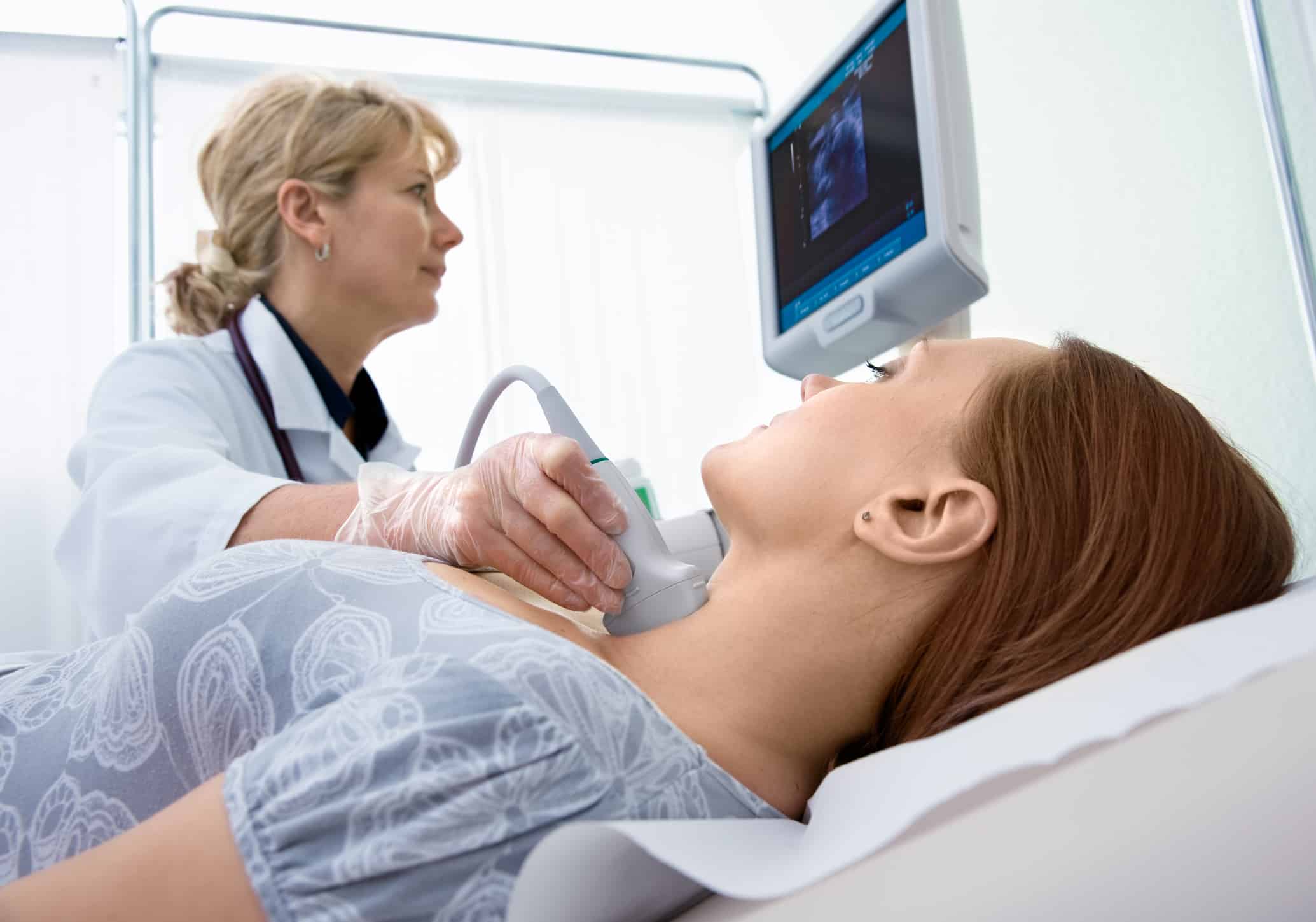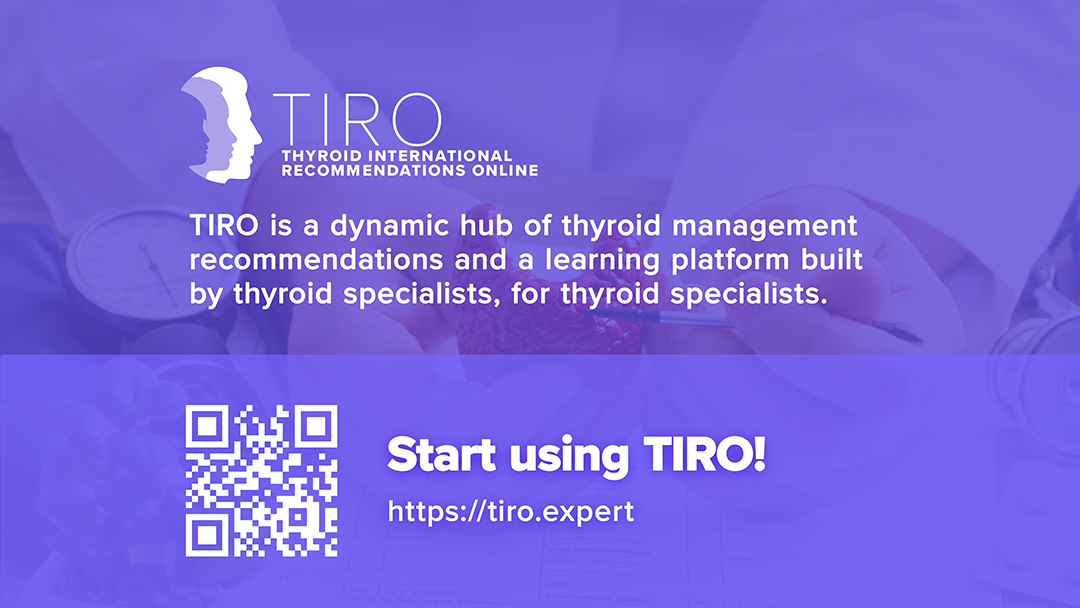For thyroid cancer, the gold standard initial imaging test is an ultrasound. Ultrasounds are almost always used to evaluate thyroid nodules, and are also often used to examine lymph nodes in the surrounding area.
An ultrasound is a type of imaging study that uses ultrasonic sound waves to produce images of structures located inside the body. The frequency of the ultrasonic sound waves cannot be heard by humans. They can travel through soft tissue and fluids, but they bounce back off of denser structures, such as bone. Ultrasounds are used to show blood vessels, organs, and lymph nodes all over the body. However, since the sound waves cannot travel through bone, ultrasounds are not used for imaging of structures located deep in the chest, face, or head.
What to Expect
Ultrasounds are completely safe and do not hurt. During an ultrasound, a technician or a radiologist will place ultrasound gel over the area being examined. They will then move a plastic probe around the area through the gel. This probe is responsible for producing the sound waves and taking pictures. The images will show up on a computer screen in real-time and the technician will likely move the probe around at different angles in order to get enough images of all the relevant structures. The time it takes to complete the exam varies, but it is usually between 15 and 30 minutes.
Advantages
- Ultrasounds do not use any radiation, so they are completely safe.
- Ultrasounds do not cause pain or discomfort.
- Ultrasounds are dynamic, meaning that the technician can see the images while performing the test and can focus on areas of concern.
- While the ultrasound is being performed, a doctor can place a needle into any concerning structures and sample cells for a biopsy (called an ultrasound-guided biopsy) which will be examined under the microscope.
Disadvantages
Ultrasounds cannot be used to image any areas hidden behind bone (such as inside the head) because the sound waves cannot travel through bone.
Ultrasound Characteristics
Ultrasound images of the thyroid gland tend to have specific characteristics that can convey information about the health of the thyroid and the presence of disease. If a nodule is present within the thyroid gland, it will generally be visible on ultrasound imaging, and its appearance will be evaluated in order to gain clinical information about the nodule itself. Different classification systems have been developed to predict a thyroid nodule’s risk of malignancy based on the nodule’s characteristics on ultrasound imaging. These characteristics must be carefully evaluated by the doctor performing the ultrasound in order to correctly classify the risk of malignancy and determine if a biopsy is needed.
Composition
The composition of thyroid nodules is an important feature in the assessment of a nodule’s risk of malignancy. Thyroid nodules can be solid, cystic (fluid-filled), or have mixed cystic/solid components.
- Cystic Nodules
Benign and rarely need to be biopsied. If the cyst is large and compresses the esophagus, this can cause difficulty swallowing (dysphagia). The cyst can be biopsied and then drained to reduce its volume. Cystic nodules can recur, which may require more drainage. Recurrence can be avoided with the use of alcohol ablation, a minimally invasive procedure to destroy the nodule. - Mixed Nodules
Low risk of malignancy. - Solid Nodules
Greatest risk of malignancy.
Echogenicity
Echogenicity describes the density of the nodule and consists of one of 3 types.
- Hypoechoic (darker): Highest risk of malignancy.
- Isoechoic: Intermediate risk of malignancy.
- Hyperechoic (brighter): Lowest risk of malignancy.
Shape
Thyroid nodules are also classified according to their shape, and are broken into categories: taller than wide or wider than tall.
- Taller than Wide
Higher risk of malignancy. - Wider than Tall
Lower risk of malignancy.
Margins
The assessment of a thyroid nodule’s margins is very important. The margins can be categorized as: smooth, ill-defined, lobulated or irregular.
- Smooth Margins
Capsule surrounding the nodule that has not been invaded by malignant thyroid tissue. - Ill-defined, Lobulated or Irregular Margins
Increased risk of malignancy and calls for a biopsy.
Echogenic Foci
Echogenic foci refer to the presence of “bright spots” within the thyroid nodule, which can be seen on ultrasound. The presence of these dot-shaped bright spots or calcifications is indicative of a higher risk of malignancy.
It is important to highlight that alone none of the previously mentioned features is indicative of thyroid cancer. However, the combination of several of these features increases the risk of malignancy of a thyroid nodule. According to the presence of these features, thyroid nodules will be categorized into: very low, low, intermediate, and high risk of malignancy.
Patients with very low suspicion of thyroid malignancy based on ultrasound features are only considered candidates for a biopsy when a nodule is greater than or equal to 2cm in size. Patients with low, intermediate, or high risk of malignancy are biopsied when a nodule is greater than or equal to 1 cm in size.
Thyroid Imaging, Reporting & Data System (TIRADS)
The most widely used classification system for thyroid nodules is named the TIRADS. This classification system assigns “points” based on the presence of nodule characteristics. These points are added together to provide a score that determines the risk of cancer in a nodule. Your doctor will decide the best treatment course for you based on classification of the nodule(s) identified.
TIRAD-ACR Scoring System
| Category | Description | Score |
|---|---|---|
| Composition | Cystic or almost completely cystic | 0 points |
| Spongiform | 0 points | |
| Mixed cystic and solid | 1 point | |
| Solid or almost completely solid | 2 points | |
| Echogenicity | Anechoic | 0 points |
| Hyperechoic or isoechoic | 1 point | |
| Hypoechoic | 2 points | |
| Very hypoechoic | 3 points | |
| Shape | Wider-than-tall | 0 points |
| Taller-than-wide | 3 points | |
| Margins | Smooth | 0 points |
| Ill-defined | 0 points | |
| Lobulated or irregular | 2 points | |
| Extra-thyroidal extension | 3 points | |
| Echogenic Foci | None or large comet-tail artifacts | 0 points |
| Macrocalcifications | 1 point | |
| Peripheral (rim) calcifications | 2 points | |
| Punctate echogenic foci | 3 points |
The sum of the points from each category above will determine the level in the TIRADS classification system:
Score Level Interpretation Suggested Action 0 points TIRADS 1 Benign no FNA 2 points TIRADS 2 Not suspicious no FNA 3 points TIRADS 3 Mildly suspicious FNA if > 2.5 cm … Follow if > 1.5 4–6 points TIRADS 4 Moderately suspicious FNA if > 1.5 … Follow if > 1 ≥ 7 points TIRADS 5 Highly suspicious FNA if > 1 cm … Follow if > 0.5

Download This Section
Feel free to download and print this page.
It’s free for personal use and to share with others you think might benefit from the information provided.











